The 250-year-old subscription library thriving in a digital world
- Published
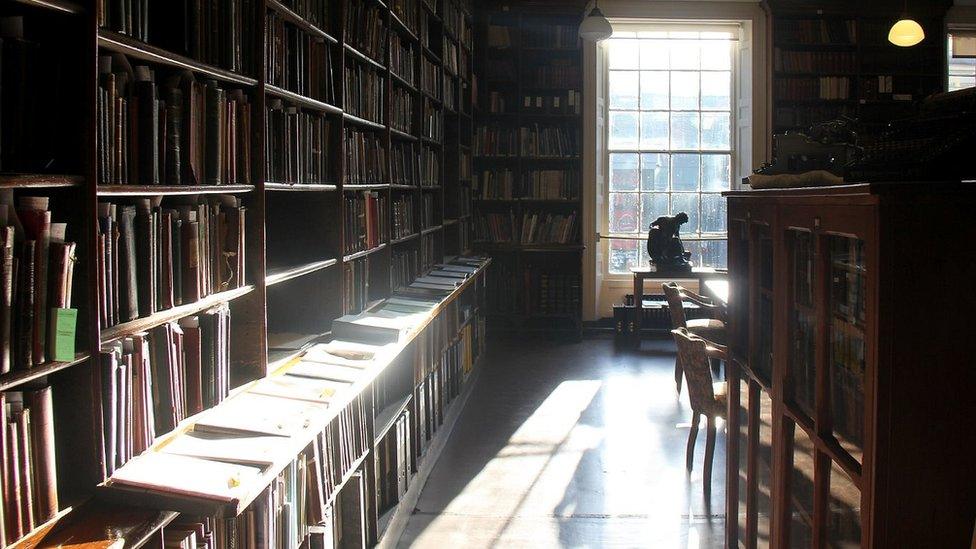
The Leeds Library has a collection of 140,000 books, with music from buskers on the street below often drifting into the reading room
The Leeds Library is the oldest surviving subscription library of its type in the UK, with its 140,000 books ranging from crumbling Victorian novels to the latest Robert Galbraith best seller. As the cultural hidden gem celebrates its 250th year, the BBC pays a visit to see how it attempts to protect its legacy while staying relevant to an increasingly distracted audience.
Sitting above a card shop and a bank on one of Leeds's busiest shopping streets, the library building can easily pass you by unless you look up and spot its blue plaque and gold signage.
"My first visit was love at first sight, it was the most magical experience," says Martin Staniforth, library chair of trustees.
"All of these books in a building I'd walked past dozens of times and never given a second glance."
Established in 1768, The Leeds Library is housed inside a three-storey Grade II* Greek revivalist structure on Commercial Street, with only the very highest book shelves visible from street level.
The Leeds Library was established in 1868
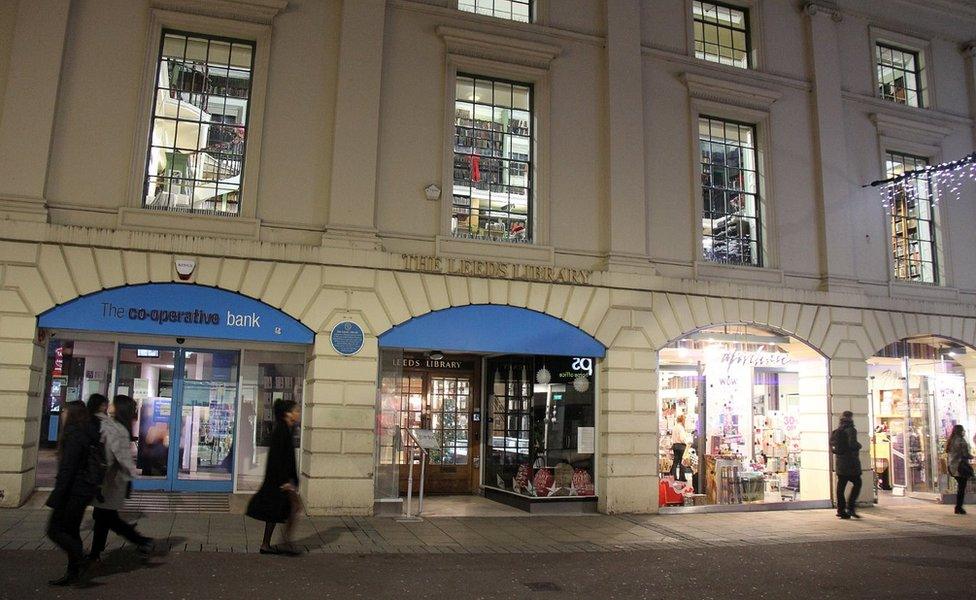
Many people walk along the busy Commercial Street without noticing the library, despite a blue plaque and a gold sign
"You get serenaded into the quiet room by the buskers singing 'Halelluiah' on the street outside, but it's far from the madding crowd when you come in," new member Nad Fiorrucci, 63, says.
"It has a wonderful aura about it."
Subscription libraries became a common feature of towns and cities in the late 18th and early 19th centuries, at a time when there were no public libraries and only a handful of university libraries.
As books were increasing in popularity but were expensive to buy, groups of people combined their funds to form libraries useful each day and "of increasing value in the future", according to the Independent Libraries Association.

The Leeds Library builds its collection by 1,500 books a year through a recommendation system by its paying members
Along with most of the other private libraries at the time, The Leeds Library was predominantly a place for the middle classes, with membership capped at 500 people.
Trustees admit it remained this way right up until 2008 when the library became a charity, doubling its membership in the process.
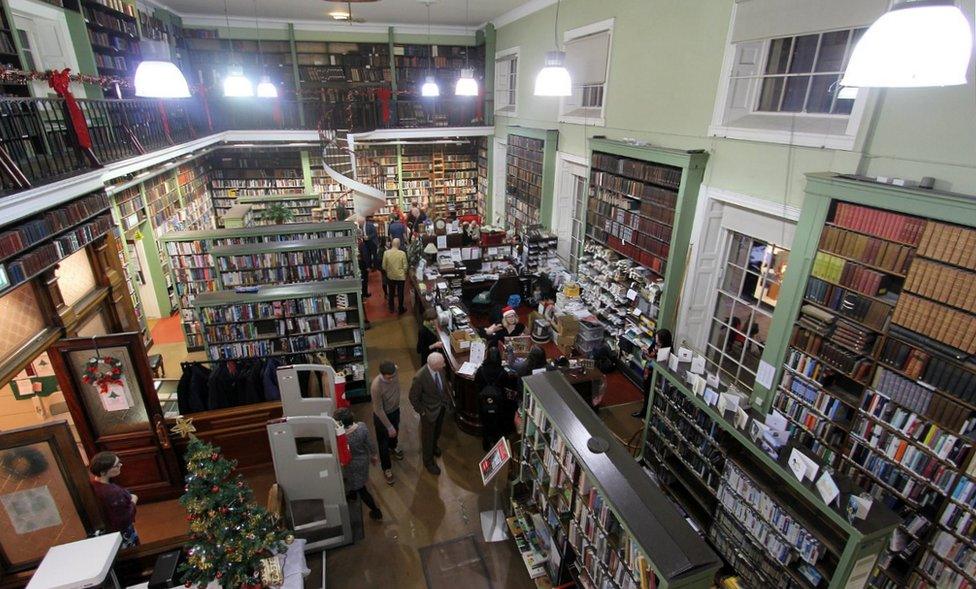
The Leeds Library's librarian says in previous years it was "very snooty", but this had completely changed since it became a charity in 2008
"You had to apply to become a member, you had to get a share, you were interviewed - the only way to describe it was exclusive," says Carl Hutton, the library's chief executive.
"Thankfully, the trustees at the time realised it's not the way things are done any more and we should open our doors up - the library's thrived by opening its doors."

Subscription libraries - a history
Subscription libraries were also known as proprietors' libraries because members owned shares in them
With the passing of the Public Libraries Act in 1850, most were replaced or taken over by local government and opened free of charge to the public
The Leeds Library opened in 1768 and is the oldest surviving subscription library of its kind in the UK
The first one in Britain was the Leadhills Miners Library in Lanarkshire, which was started in 1741 by 21 miners, a minister and schoolmaster.
The most expensive of the UK's subscription libraries today is the Liverpool Athenaeum, where a Category A membership costs £795 a year

A yearly membership currently costs £132, or £66 for people aged between 18 and 25.
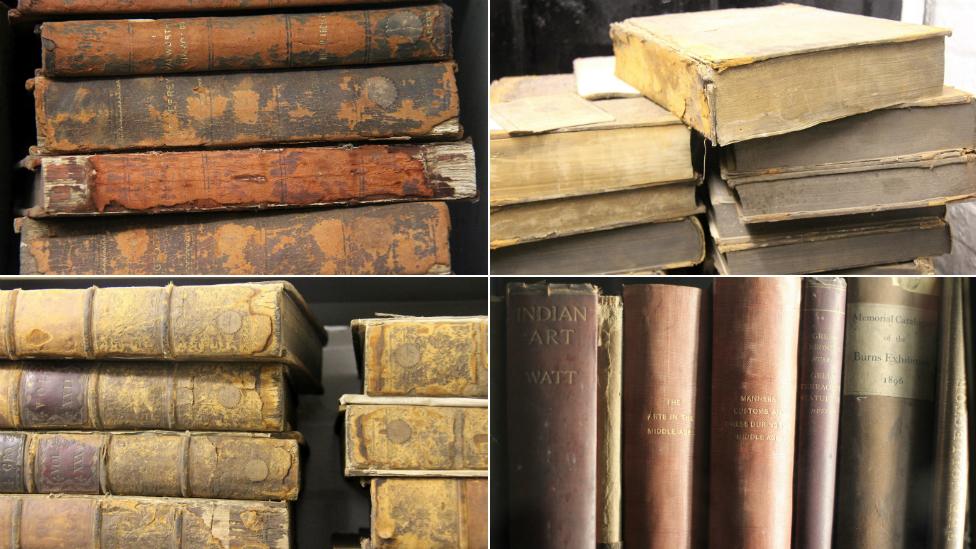
Some of the Victorian books kept in the basement area are in the process of being treated for "red rot", where the leather covers and spines degrade over time
The library has seen a colourful mix of characters of varying professions over the years, with current members including actors, judges and decorative artists.
Alister MacKenzie, a member of the library for 25 years, was a golf course designer whose masterpiece was Augusta, arguably the USA's most famous course, which opened in 1933.
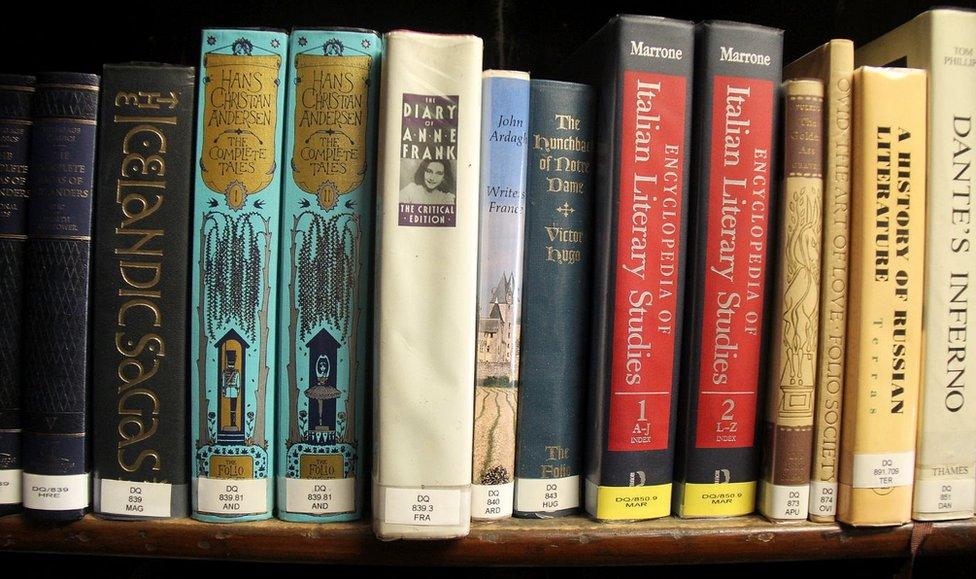
Classics on the shelves include the Diary of Anne Frank, the Complete Tales of Hans Christian Andersen and The Hunchback of Notre-Dame by Victor Hugo
Andrew Graham, a 41-year-old author, has been a member for three years and used the space to research a book he was writing.
He says: "I came in and asked, 'have you got anything on York?' They replied, 'we've got Francis Drake's Eboracum from 1736'. I said, 'that will do'.
"I didn't even need to wear gloves, they just told me to take it away and lumped this huge book on the counter."
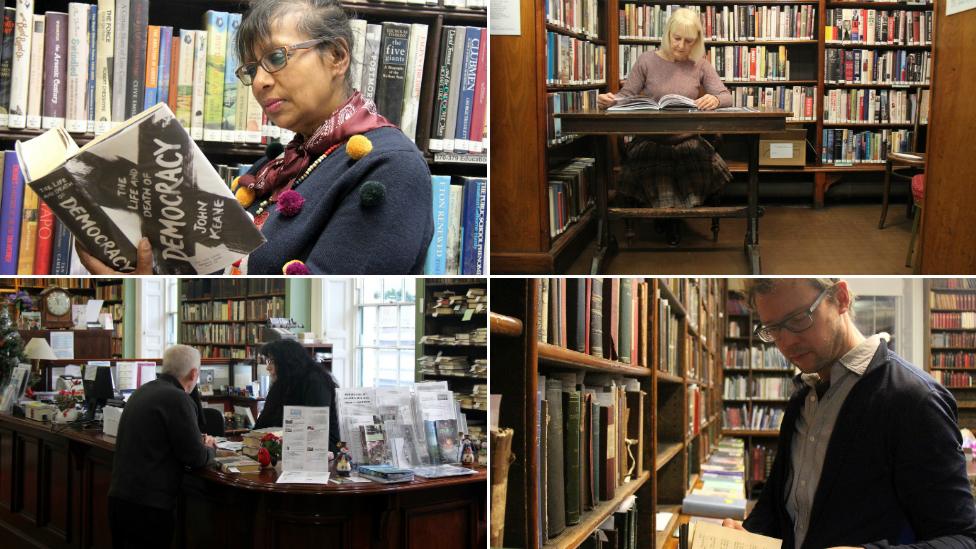
(From top left, clockwise) Members Nad Fiorrucci, Angela Beaumont, Andrew Graham and librarian Jane Riley
Mr Hutton says: "For some people, the library is the thing that gets them up out of bed in the morning.
"We have writers who come here to enjoy the ambience and find it's an industrious place to work, we have some people who just love reading books and a younger element who like that we're diversifying into events."
To celebrate its milestone, the library has hosted about 200 events including film screenings, poetry nights, author talks and theatre performances, working with 32 different organisations in the process.
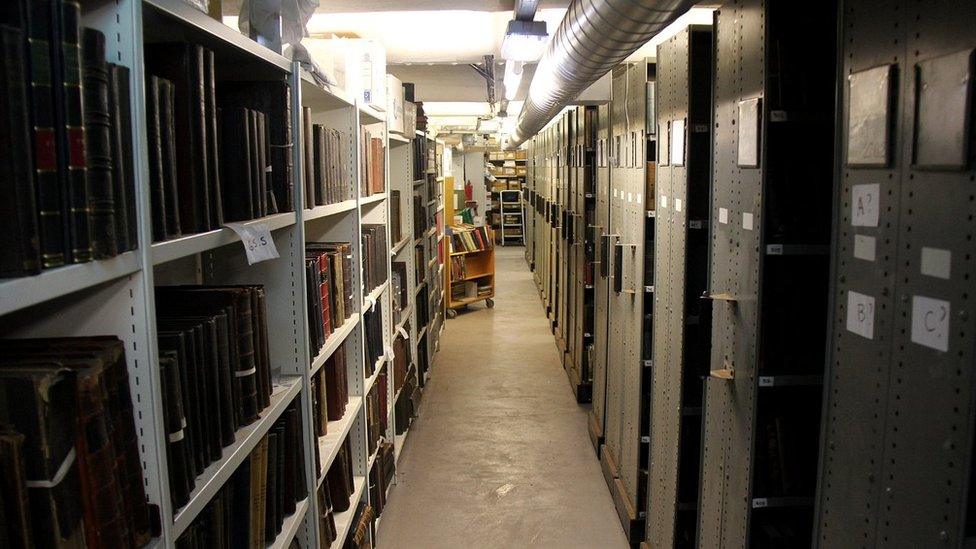
About a third of the library's collection can be found in the basement, which also has a workshop for repairing rotting books
Since 2014, it has introduced hundreds of uncommon words to the public through its popular Word Of The Day posts on social media, with public events also advertised on its Twitter and Facebook pages.
Allow X content?
This article contains content provided by X. We ask for your permission before anything is loaded, as they may be using cookies and other technologies. You may want to read X’s cookie policy, external and privacy policy, external before accepting. To view this content choose ‘accept and continue’.
Mr Hutton adds: "In many ways, the internet and social media are the nemesis of libraries, because of access to information, but it's actually been our salvation.
"It's led to us being able to promote a private library, so what is an issue for public libraries has actually been brilliant for us. Without it, people wouldn't even know we were in Leeds."
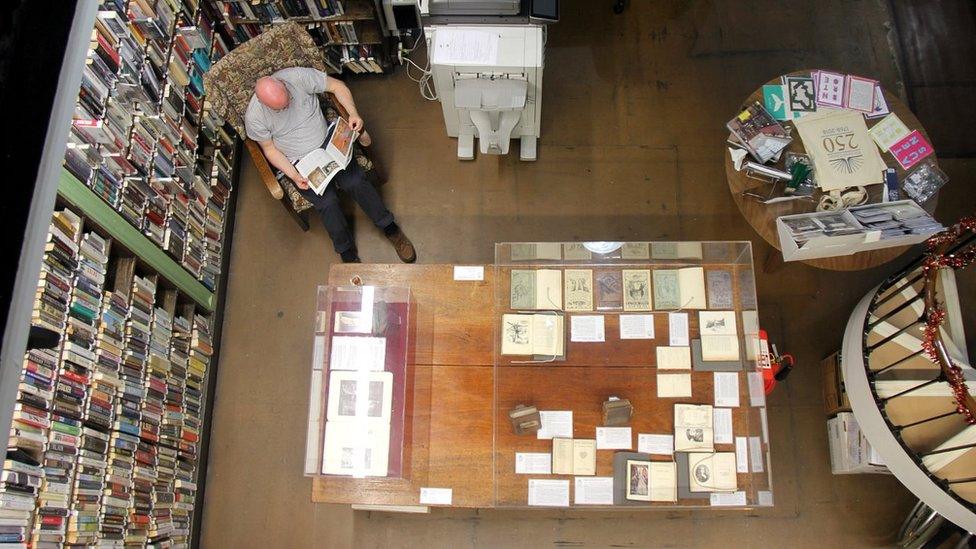
The library was turned into a charity in 2008 and saw its membership double in ten years
Mr Staniforth says: "We retain our relevance because increasingly we've put on these nights, which are open to the public and are attracting in a different audience than we had 20 years ago.
"Financially we also benefit from rental income from the shops underneath the library, our forefathers who built it were very forward thinking in that respect."

The library has hosted about 200 events in its 250th year, with library president Dr Kevin Grady hosting its Christmas Sherry Party
Being a part of the library has been a family affair for Angela Beaumont, 67, whose grandfather was also a member.
"I've probably borrowed one book a fortnight since I joined 40 years ago, I'm a total insomniac so the frequency depends on how I'm sleeping really," she says.
"When I first came here the people all looked like the books, they were a bit dusty, but since they've open it up to the general public they do have more younger people."
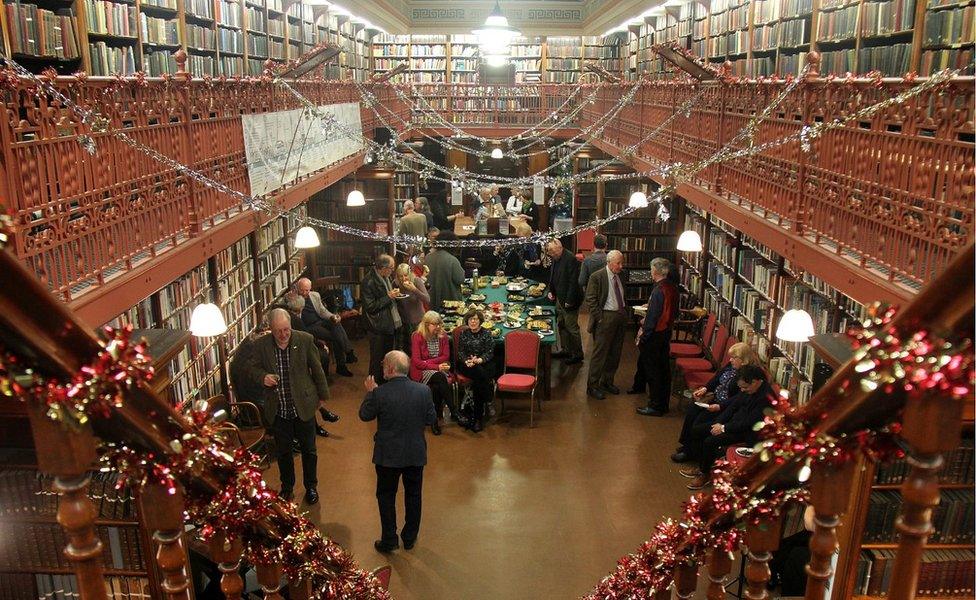
The New Room, parallel to the original library room and used for events, was added as an extension in 1880 to create more shelving space
The library grows its collection by 1,500 books a year, with members able to nominate any new titles they are hoping to read.
The oldest book in its collection is thought to be a travel journal by Sir John Mandeville published in 1483, which is in remarkably good condition.
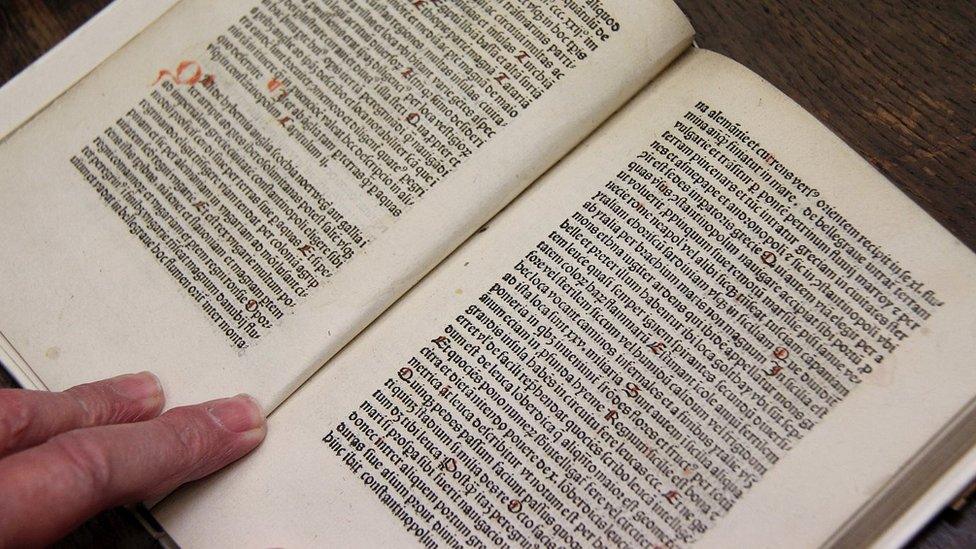
The oldest book in the library's collection is thought to be "Itinerarius a terra Anglie in partes Ierosolimitanas" by Sir John Mandeville, which was published in 1483
Jane Riley, Leeds Library's librarian, says she is "very protective over the profession because it is a dying one".
"My equivalent colleagues in public libraries don't handle books half the time, they're helping people log on to computers and stuff like that," she says.
"I'm not saying there isn't a place for that, but the joy of this place is you actually handle the books all day and every day."
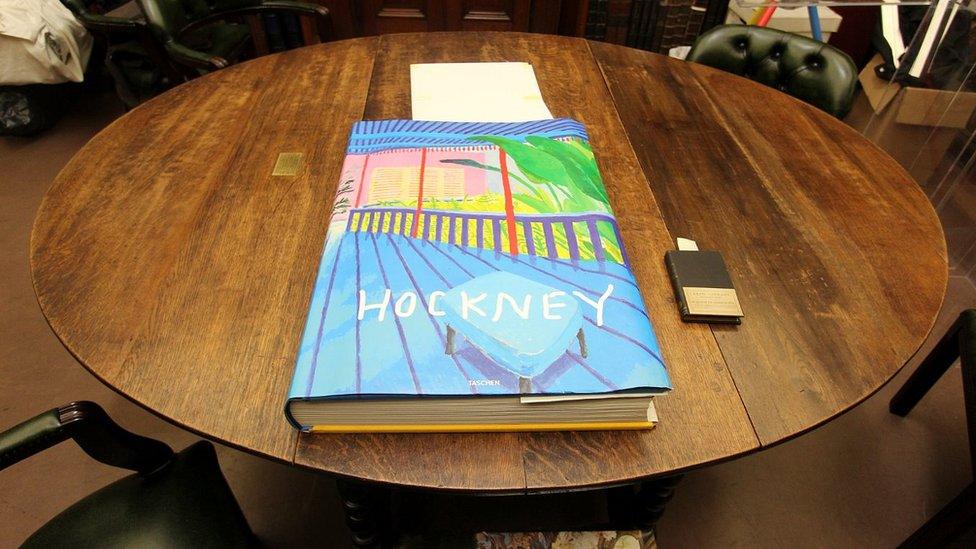
A new addition to the collection is Yorkshire artist David Hockney's "A Bigger Book", which is one of only 9,000 and is the largest title in the library
A recent addition she has had to stamp up and catalogue is a huge book sharing the work of world-renowned Yorkshire artist David Hockney, which came with its own stand.
Mrs Beaumont adds: "Perhaps libraries don't have the same input in people's lives, but if I had to pick between 50 gigabytes of information in a computer folder or a book.. I know which I'd choose."

The Leeds Library's most-borrowed list of 2018
Becoming - Michelle Obama (non-fiction)
I'll Keep you Safe - Peter May (fiction)
This is Going to Hurt - Adam Kay (non-fiction)
Tombland - C.J. Sansom (fiction)
Fire and Fury: Inside the Trump White House - Michael Wolff (non-fiction)
London Rules: Jackson Lamb Thriller 5 - Mick Herron (fiction)

Photos by Tom Airey
- Published10 April 2016
